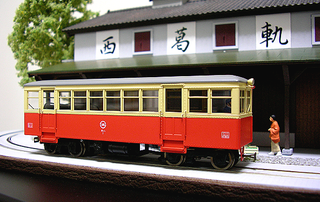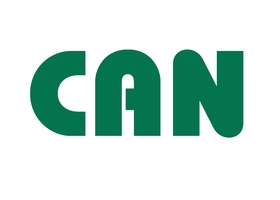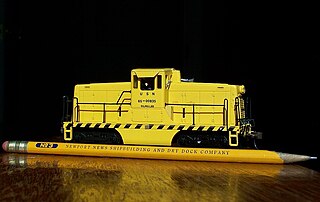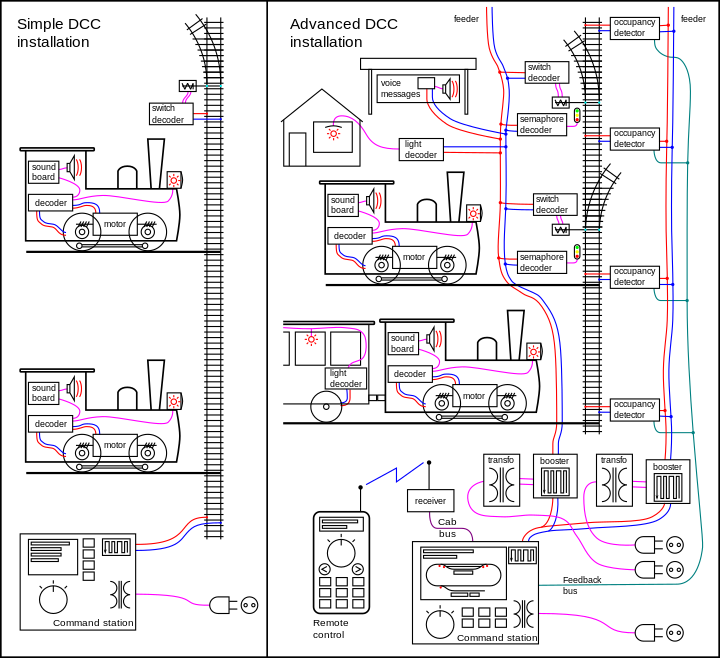
Railway modelling or model railroading is a hobby in which rail transport systems are modelled at a reduced scale.

A controller area network is a vehicle bus standard designed to allow microcontrollers and devices to communicate with each other. It is a message-based protocol, designed originally for multiplex electrical wiring within automobiles to save on copper, but it can also be used in many other contexts. For each device, the data in a frame is transmitted serially but in such a way that if more than one device transmits at the same time, the highest priority device can continue while the others back off. Frames are received by all devices, including by the transmitting device.

Power-line communication (PLC) is the carrying of data on a conductor that is also used simultaneously for AC electric power transmission or electric power distribution to consumers. The line that does so is known as a power-line carrier.

A third rail, also known as a live rail, electric rail or conductor rail, is a method of providing electric power to a railway locomotive or train, through a semi-continuous rigid conductor placed alongside or between the rails of a railway track. It is used typically in a mass transit or rapid transit system, which has alignments in its own corridors, fully or almost fully segregated from the outside environment. Third-rail systems are usually supplied from direct current electricity.

A diesel locomotive is a type of railway locomotive in which the power source is a diesel engine. Several types of diesel locomotives have been developed, differing mainly in the means by which mechanical power is conveyed to the driving wheels. The most common are diesel-electric locomotives and diesel-hydraulic.

O scale is a scale commonly used for toy trains and rail transport modelling. Introduced by German toy manufacturer Märklin around 1900, by the 1930s three-rail alternating current O gauge was the most common model railroad scale in the United States and remained so until the early 1960s. In Europe, its popularity declined before World War II due to the introduction of smaller scales.

HO or H0 is a rail transport modelling scale using a 1:87 scale. It is the most popular scale of model railway in the world. The rails are spaced 16.5 millimetres (0.650 in) apart for modelling 1,435 mm standard gauge tracks and trains in HO.

N scale is a popular model railway scale. Depending upon the manufacturer, the scale ranges from 1:148 to 1:160. Effectively the scale is 1:159, 9 mm to 1,435 mm, which is the width of standard gauge railway. However the scale may vary to simulate wide or narrow gauge rail. In all cases, the gauge is 9 mm or 0.354 in. The term N gauge refers to the track dimensions, but in the United Kingdom in particular British N gauge refers to a 1:148 scale with 1:160 track gauge modelling. The terms N scale and N gauge are often inaccurately used interchangeably, as scale is defined as ratio or proportion of the model, and gauge only as a distance between rails. The scale 1:148 defines the rail-to-rail gauge equal to 9 mm exactly, so when calculating the rail or track use 1:160 and for engines and car wheel base use 1:148.

Gebr. Märklin & Cie. GmbH or Märklin is a German toy company. The company was founded in 1859 and is based at Göppingen in Baden-Württemberg. Although it originally specialised in doll house accessories, today it is best known for model railways and technical toys. In some parts of Germany and in Sweden, the company's name is almost synonymous with model railways.
Z scale is one of the smallest commercially available model railway scales (1:220), with a track gauge of 6.5 mm / 0.256 in. Introduced by Märklin in 1972, Z scale trains operate on 0–10 volts DC and offer the same operating characteristics as all other two-rail, direct-current, analog model railways. Locomotives can be fitted with digital decoders for independent control. Model trains, track, structures, and human/animal figures are readily available in European, North American, and Japanese styles from a variety of manufacturers.

Hornby Hobbies Limited is a British-owned scale model manufacturing company which has been focused on model railways. Its roots date back to 1901 in Liverpool, when founder Frank Hornby received a patent for his Meccano construction toy. The first clockwork train was produced in 1920. In 1938, Hornby launched its first OO gauge train. In 1964, Hornby and Meccano were bought by their competitor, Tri-ang Railways, and sold when Tri-ang went into receivership. Hornby Railways became independent again in the 1980s, and became listed on the London Stock Exchange, but due to financial troubles reported in June 2017, became majority owned by British turnaround specialist Phoenix Asset Management.
Trainmaster Command (TMCC) is Lionel's electronic control system for O scale 3-rail model trains and toy trains that mainly ran from 1994 to 2006. Conceptually it is similar to Digital Command Control (DCC), the industry's open standard used by HO scale and other 2-rail DC trains. It has one advantage over DCC, in that TMCC-equipped locomotives can run simultaneously with non-TMCC locomotives and Lionel Legacy engines as well as LionChief and LionChief Plus equipped locomotives. The latter require a dedicated remote controller. MTH Corporation's DCS controller can be configured to control TMCC locomotives, and all four systems can be operated on the same track simultaneously. Each simply requires a constant track voltage. TMCC/Legacy "broadcasts" its signal to the antenna on the locomotives which listen for signals that first identify the particular locomotive by number and then it issues given commands as to speed, direction, sounds, lighting and other features. DCS performs similar functions but transmits a carrier over the rails which are picked up through the locomotive's electrical pickup contacts. While TMCC/Legacy and DCS remote controls relay operator commands to a device that transmits them to the train, LionChief/LionChief+ also issue remote control commands but the remote and locomotive are married and each locomotive requires a separate remote control. This system requires no additional wiring as the control is directly "narrowcast" to the locomotive in the same way as a television remote control or garage door opener functions. In 2017, Lionel released a universal remote for LionChief+ that will learn addresses for up to three locos at a time, simplifying the operation of multiple trains.

A slot car or slotcar is a powered miniature automobile or other vehicle that is guided by a groove or slot in the track on which it runs. A pin or blade extends from the bottom of the car into the slot. Though some slot cars are used to model highway traffic on scenic layouts, the great majority are used in the competitive hobby of slot car racing or slot racing.
RS-485, also known as TIA-485(-A) or EIA-485, is a standard, originally introduced in 1983, defining the electrical characteristics of drivers and receivers for use in serial communications systems. Electrical signaling is balanced, and multipoint systems are supported. The standard is jointly published by the Telecommunications Industry Association and Electronic Industries Alliance (TIA/EIA). Digital communications networks implementing the standard can be used effectively over long distances and in electrically noisy environments. Multiple receivers may be connected to such a network in a linear, multidrop bus. These characteristics make RS-485 useful in industrial control systems and similar applications.
Märklin Digital was among the earlier digital model railway control systems. It was a comprehensive system including locomotive decoders, central control, a computer interface, turnout decoders, digital relays and feedback modules. The initial system was presented at the 1979 Nürnberg International Toy Fair, released in Europe in 1985 and the USA in 1986 under the name Digital H0.

A garden railway or garden railroad is a model railway system set up outdoors in a garden. While G is the most popular scale for garden railroads, 16 mm scale has a dedicated and growing following especially in the UK. Model locomotives in this scale are often live steam scale models of British narrow gauge prototypes. 16 mm scale track, the same gauge as O gauge is probably now more popular in the UK than G scale.
A power booster is a combination of motor-mechanical power amplifier- generator. For example a 30kw motor with the power amplifier could power a 100kw generator. This power booster is now commercially available
Rocrail is a freeware software package for controlling a model train layout from one or more computers. Users can run trains directly from a computer, or have some run automatically with manual control for any others.
Digital model railway control systems are an alternative to control a layout and simplify the wiring and add more flexibility in operations. A number of control systems are available to operate locomotives on model railways. Analog systems where the speed and the direction of a train is controlled by adjusting the voltage on the track are still popular while they have recently given way to control systems based on computer technology.














